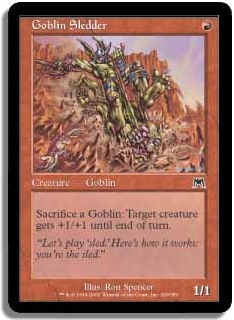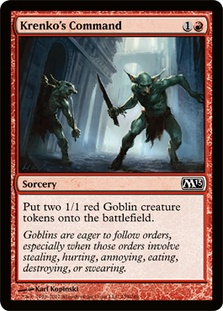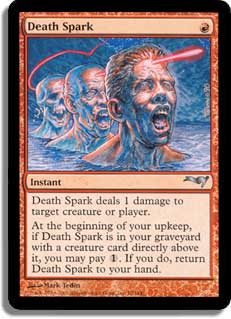Has there ever been a common a drafter wanted to open more than Sparksmith? The Goblin was one of the best sights in an Onslaught Block Draft, setting drafters well on their quest for a win, even if only a few more Goblins were picked up along the way.
With these memories relatively fresh in my mind, I built my first Pauper (then PDC) deck in the spring of 2005. It was not quite Goblin tribal, but it used Sparksmith to control the board and Goblin Sledder to help eke out damage. Top Deck Red, as it came to be known, quickly found a spot as the then clock of PDC and ushered in an age of Mountains.
Creatures (26)
- 4 Goblin Cohort
- 4 Frostling
- 4 Sparksmith
- 4 Ronin Houndmaster
- 4 Oxidda Golem
- 3 Vulshok Berserker
- 3 Goblin Sledder
Lands (19)
Spells (15)

Fast forward to sanctioned Pauper. Mono-Black Control was riding high on the back of Tendrils of Corruption. Tendrils was one of the defining spells of the early days of the format, taking a threat off the battlefield while undoing one (sometimes even two!) attacks. With that in mind, here is the deck I played in the third Pauper Premier Event in May 2009:
Creatures (22)
Lands (22)
Spells (16)
Sideboard

I finished 10th, but I was well positioned to fight Tendrils. Carrion Feeder and Nantuko Husk not only provided extra utility from dying creatures but effectively turned Tendrils into a four-mana Doom Blade. This deck would never rise to the occasion again thanks to damage no longer going on the stack, yet key elements of it would survive in the form of Goblins.
For a long time Goblins was fringe deck. Spectacular cards like Mogg War Marshal and Goblin Bushwhacker were held in check by Tendrils, even with the existence of Goblin Sledder. Sure, Skirk Prospector existed as a secondary sacrifice outlet, but there was no way to profit from the mana. When Tempest rolled out in the digital realm, Mogg Raider in tow, everything changed. The addition of Raider gave Goblins an additional one-drop that fought Tendrils and dealt damage. Mono-Black Control had greater difficulty in surviving against Goblins. Corrupt on six was no longer cutting it. Thus, the modern Goblin deck was born.
Goblins is more than just beatdown. Every creature interacts in a highly beneficial way, making the deck far more than the sum of its parts.
Goblin Sledder / Mogg Raider is the driving force behind the deck. Not only are they capable of providing an extra punch, but they also force an opponent to change how they play removal, as killing a creature pre-combat does not seem as enticing when it will still deal damage. This duo also allows Goblins the option of ignoring echo on Mogg War Marshal—a turn 1 Sledder can swing for two (or three or four but usually just two) if followed by a turn 2 Marshal and leave back two tokens to block. These two are also key in managing Goblin count for Sparksmith, helping to ensure the Goblin mage does not burn themself to death.
Mogg War Marshal is the other key element of Goblins. Three power for two mana, Mogg War Marshal can absorb a block or provide a significant damage boost. In conjunction with Goblin Bushwhacker, one War Marshal can eat 30% of an enemy life total. The Marshal also is everything you want against decks with removal—one spell just will not cut it. Mogg War Marshal, in a word, is pesky.
Goblin Bushwhacker is also an important part of the deck because giving an army haste and a power boost for two mana is well above the curve. Most Goblin decks top out at two mana, so it is not beyond of the realm of possibility to play out to creatures in the mid game and follow them up with a Bushwhacker for a serious amount of damage. It is important to keep in mind that Bushwhacker also turns on Sparksmith a turn early.
Speaking of, Sparksmith is the deck’s main form of board control. The magic number is four—Spire Golem and Stitched Drake are the best blockers against Goblins, but a Sparksmith on four helps to mitigate that problem (at a price). More often, Smith helps take out blockers after combat (and at greatly reduced rate of self harm).
Goblin Cohort and Mogg Conscript are the bread and butter two-power one-drops of Goblins. Their drawback does come into play, but Goblin decks tend to be around two-thirds creatures, so they will be “on” more often than not. And they can always block.
Mogg Flunkies is another sizable creature that does not always want to attack. Unlike Cohort and Conscripts, the Flunkies just need another creature available to do their damage. The Flunkies are largely an offensive tool, as you rarely want to be blocking with two creatures anyway, and throwing away your largest creature is wrong more often than not. Flunkies are also key against blue decks, as they can tag team with a Sledder or Raider to take down blue’s best blockers (the previously mentioned Golem and Drake).
Goblin Arsonist has replaced Mogg Fanatic now that damage is no longer stack-worthy. The value of Arsonist has gone up as more decks run creatures with one toughness. In Goblins, it is often better than Mr. Fantastic as it can deal its point of damage and provide a power boost via a Sledder.
Goblin Matron sees play in “slower” Goblin builds that tend to run more land. Providing two creatures for a Cohort or Conscript, Matron can also set up a Bushwhacker turn or allow for a toolbox approach, running maindeck bullets.
Mudbrawler Cohort is a relatively weak two-drop, its strength relying on another red creature being in play. However, it shines in concert with Mogg Flunkies, making it an excellent topdeck in the mid game when Flunkies is the only creature on your side.
Dragon Fodder and Krenko’s Command act as two-thirds of Mogg War Marshal but are not actual creatures. This means they do not turn on Cohort or Conscript, cannot be Tutored up by Goblin Matron, and do not turn on Death Spark (more on this later).
The deck sometimes reaches outside tribal lines for some additional punch. Bloodfire Dwarf and Martyr of Ashes are one drops that fight the good fight against Empty the Warrens combo and other swarm decks. While they often find home in sideboards, it is not unheard of to seem them in the main 60.
Jackal Familiar is a Goblin Cohort body with a Mogg Flunkies mindset. While not actually a one-drop (thanks to a drawback), the Familiar makes appearances in the most aggressive and creature oriented builds of the deck.
Hissing Iguanar gives a combo feel to Goblin decks, turning every dying creature into even more damage—Iguanar effectively doubles the damage from each Sledder or Raider activation. Costing as much as it does, Iguanar is seen as a top end for Goblins and is not the kind of card that merits four slots.
Here is a trio of Goblins that do not see heavy play but might have a home either as a maindeck inclusion or as Matron targets.
Goblin Fireslinger is a source of repeatable damage on a one-drop. I have tested the Fireslinger, and it seemingly comes into play with a target on its head. Against blue decks that lack Piracy Charm, Fireslinger can end the game.
Stingscourger is an on-tribe way to clear out creatures too large to kill with Sparksmith. While the echo cost is steep, Goblins does have Sledder and Raider available to help offset the cost and turn the Goblin-o’-War into extra damage.
Finally, Rummaging Goblin warrants a closer look. While I have made my feelings on the design of this card known, it is still a Looter and can help mitigate flood late. Many of the losses I have suffered with Goblins occurred after I drew land after land. Rummaging Goblin, as expensive as it is, is a tribal way to fix this issue, unlike Faithless Looting or Wild Guess. It also can be used to discard a Death Spark under a dying creature if the need arises.
The spells of a Goblin deck always start the same way: four Lightning Bolt. The best value is still the best value, and it does kill just about everything in Pauper while doubling as a finisher. After Lightning Bolt, however, things get interesting.
Many decks turn to Chain Lightning. Like the Bolt but a sorcery, Chain Lightning is a liability against red decks. Seeing as how Goblins and Izzet Post are both popular decks, running the full four might be hazardous to one’s health.
Fireblast is a common two of, as lands lose their value late. Sacrificing two to end the game is a bargain. Seeing one in an opener helps to craft a game plan. That being said, it is often a “win more” card, and there might be better options for different metagames.
Death Spark is one of the grindiest cards available to Goblins and is capable of dealing a ton of damage over the course of a game. Early, it helps to clear out blockers and utility creatures. Proper Death Spark management is key, however, so never get caught in a situation where a noncreature will land on top of one in the bin if you can help it. Late in the game, Goblins might seemingly throw away creatures to help gain value out of Death Spark. Spark is also a fantastic way to fight counterspells; casting it in response to a counter means it can recur at a later time.
Flame Jab trades excess land for damage. Personally, I prefer Death Spark because it is an instant. Jab has the advantage of not caring about graveyard order, but sorcery speed is a pretty big roadblock that prevents Jab from seeing heavy play.
Reckless Abandon is another finisher in the vein of Fireblast. While a sorcery, it does combo nicely with Death Spark and the large number of creatures that Goblins does not mind having die.
Both Flame Slash and Electrostatic Bolt see play as ways to fight large blockers (mainly Spire Golem) and the armies of Affinity. It is hard to argue with the damage output of these two spells, but they cannot hit players. Goblins cannot waste cards that only hit creatures, as every point of damage has to be able to hit the dome.
One card that might want a spot is Brimstone Volley. Creatures are dying all the time, and even though the Volley costs the dreaded three mana, it will still eat a quarter of an opponent’s life total.
With all that said, here is my current list:
Creatures (35)
- 4 Goblin Cohort
- 4 Mogg Flunkies
- 2 Sparksmith
- 4 Mogg Raider
- 4 Goblin Sledder
- 4 Mogg Conscripts
- 4 Mogg War Marshal
- 1 Hissing Iguanar
- 4 Goblin Bushwhacker
- 4 Goblin Arsonist
Lands (17)
- 17 Mountain
Spells (8)
Sideboard

The rise of Fume Spitter has made Goblin Arsonist a more attractive option. Hissing Iguanar also can wreak havoc in the mirror and against other swarms.
Here is a brief matchup guide. Pauper is a format of inches—you either are favored by a small margin or a dog by the slimmest percentage…unless the matchup is an utter blowout.
Delver Blue
Your biggest enemy might be Spellstutter Sprite as it represents a virtual Time Walk that can also nullify a significant portion of your deck. Do your best to protect Flunkies since they are your main offense.
+1 Sparksmith, +3 Pyroblast, +1 Flaring Pain, -2 Chain Lightning, -1 Death Spark, -1 Mogg Raider, -1 Hissing Iguanar
The Flaring Pain should only come in if you put your opponent on Sea Sprite or Weatherseed Faeries, as Pain can make the damage from their blocks resolve. I have pulled this off on more than one occasion and could almost hear the air leave my adversary’s lungs.
Affinity
Affinity is a straight up race. Game 1 is a coin flip—if you can keep them off their four-power creatures, you are in good shape.
+1 Sparksmith, +3 Gorilla Shaman, +1 Smash to Smithereens, -1 Chain Lightning, -1 Death Spark, – 2 Goblin Arsonist, -1 Hissing Iguanar
Protect a Gorilla Shaman at all costs—it is not a turn 1 play. Rather, play it only when you can destroy a land or other cheap artifacts.
White Weenie
White Weenie is on the rise thanks to the addition of War Falcon to the Pauper arsenal. Another race, you want to be faster than their blockers and avoid situations where you can be blown out by maindeck Prismatic Strands. You also want to do your best to win before they can cast a Squadron Hawk for a stream of blockers.
+2 Sylvok Lifestaff, +1 Sparksmith, +1 Flaring Pain , -1 Goblin Bushwhacker, -1 Mogg Raider, -1 Hissing Iguanar, -1 Mogg Conscripts
In games 2 and 3, you want to play a slightly more controlling role using Sparksmith to keep their army low, which is harder now thanks to Doomed Traveler and Loyal Cathar. Sylvok Lifestaff is key in keeping your life total high enough to use Sparksmith liberally, and Flaring Pain is for punching through Prismatic Strands.
Stompy
Stompy is yet another race. You have a better early game, but they have Rancor, which can be problematic. Post-board, you should be able to block many of their assaults, and one Sylvok Lifestaff can do a ton of work in keeping you alive.
+1 Sylvok Lifestaff, -1 Hissing Iguanar
Infect
Infect is not fun to play against. They can win on turn 2 and there is not much you can do about it. Play defensively, keep blockers available, and do your best to keep threats off the table. Burn creatures on your turn if possible to make them waste pump spells.
-1 Mogg Flunkies, +1 Sparksmith
Rats / Mono-Black Control
If you do not win early, Goblins will eventually succumb to their removal and their two-for-ones. Protect Sledder and Raider as the do the most work in fighting potential Tendrils of Corruption and also help to neuter removal. If possible, pay the echo on Mogg War Marshal.
-1 Goblin Cohort, +1 Myr Sire
U/B and U/R Cloudpost
Cloudpost (U/B and U/R) is a miserable matchup. They have cheap removal to eat your army and Glimmerpost to negate your attacks. Many decks now run Ghostly Flicker in concert with Archaeomancer and Mnemonic Wall to gain infinite life. This is another matchup where you want to pay the echo on War Marshal.
+3 Pyroblast, +1 Myr Sire, -2 Sparksmith, -2 Goblin Arsonist
Storm
Storm combo (Empty the Warrens and Grapeshot) is another game 1 race. Try to force them to go off early, and cross your fingers that they fizzle. Post-board, you have Pyroblast to help counter key spells at choke point and Bloodfire Dwarf to wipe their army.
+3 Pyroblast, +3 Bloodfire Dwarf, -2 Sparksmith, -2 Death Spark, -1 Chain Lightning, -1 Hissing Iguanar
Temporal Storm
Temporal Storm is another race, but here you have slightly more time. Try to pick off their creatures. Some builds have switched to Archaeomancer (over Mnemonic Wall); in those cases, bring in the third Sparksmith.
+3 Pyroblast, -1 Hissing Iguanar, -2 Goblin Arsonist
Mirror
In the mirror, you want to keep a Sledder advantage and do your best to be the aggressor. Death Spark is one of the best spells you have access to, and Sparksmith is a liability.
+2 Sylvok Lifestaff, -2 Sparksmith
Goblins is a potent deck, and it will only get stronger. Goblins is a supported tribe, so be on the lookout for new cheap creatures because those drawbacks might not always matter.
Two quick notes before this wraps up:
1. Congratulations to the Standard Pauper community. A few days after my last article went live, Wizards announced that Standard Pauper is going to be an official filter for Magic Online. While there is no plan in place to sanction this play, it is a step in that direction. I will be looking at Standard Pauper decks in the future, as there is a depth of deck design for the format that does not exist in Classic.
2. Warning, Here There Be Spoilers
So Gates, common enters-the-battlefield tapped dual lands, have all but been confirmed for every color pair between Return to Ravnica and Gatecrash. This changes Pauper, as it makes a whole swath of old gold cards far more playable. While Pauper will not have access to turn 1 duals and as such pure aggro decks will likely remain multicolor, hybrid aggro and midrange decks now have access to the best mana available in Pauper. Ever.
I will be going into depth about the Gates more in the coming weeks, but for now, two thoughts. One, Putrid Leech now leaps up the ranks in amazing creatures, as it is far easier to cast on turn 2 without hindering your long game development. Two, it will one day be possible to run both Counterspell and Chittering Rats in the same deck and cast both off of three lands.
The game has changed.
Keep slingin’ commons-
-Alex
SpikeBoyM on Magic Online
The Colors of Pauper:



